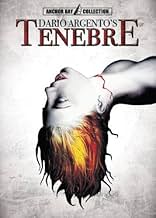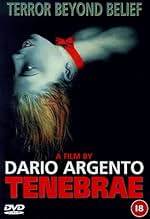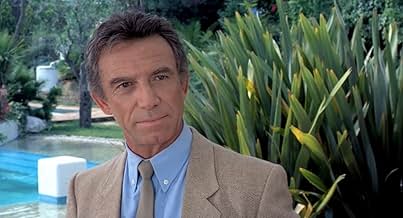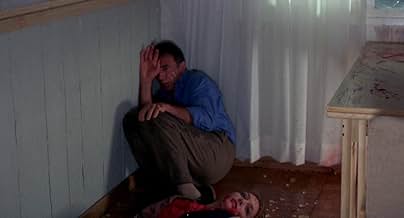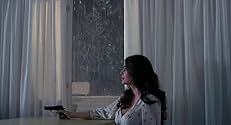An American novelist visiting Rome to promote his latest book is stalked and harassed by an obsessed fan who is committing a string of murders that appear to be tributes to his work.An American novelist visiting Rome to promote his latest book is stalked and harassed by an obsessed fan who is committing a string of murders that appear to be tributes to his work.An American novelist visiting Rome to promote his latest book is stalked and harassed by an obsessed fan who is committing a string of murders that appear to be tributes to his work.
Ennio Girolami
- Department Store Manager
- (as Enio Girolami)
Featured reviews
Tenebre (1982) is a cold, dark and sterile film from Dario Argento. In sterile I mean the clinical and septic surroundings that the city dwellers live in. Some of the sets are painted bright white and lighted in cool hues. The film is about a murder mystery writer named Peter Neal who comes to Rome on a business trip/vacation. During this trip, some murders are committed by a strange demented killer who's a big fan of Peter Neal. The film's translated title Shadow describes the film perfectly. To say how it relates to the film would be all too telling.
Some of the set pieces in this film are some of the most graphic and violent ones that Argento has ever concieved. They fit neatly within the confines of this tightly shot and directed thriller. One of Argento's best films (besides his opus Suspiria). I strongly recommend this picture. My favorite of the set pieces takes place in the final third of the movie. It's well worth the wait. Believe me.
A+
Some of the set pieces in this film are some of the most graphic and violent ones that Argento has ever concieved. They fit neatly within the confines of this tightly shot and directed thriller. One of Argento's best films (besides his opus Suspiria). I strongly recommend this picture. My favorite of the set pieces takes place in the final third of the movie. It's well worth the wait. Believe me.
A+
The Italian mastermind behind the giallo movement, Argento once again provides another enthralling crime investigative thriller poised with provocative imagery and plenty of throat slashing. This representing my third foray into his filmography, I was both sceptical and excited to see what he would produce. As soon as that 80s horror score kicked in almost immediately, I was invested. The author of the recent hit "Tenebrae" travels to Rome for promotional events, but is quickly caught up in a murder mystery to which the killer utilises phrases from his book leaving clues to the next victim.
The backbone of the narrative is reminiscent of his directorial debut 'The Bird with the Crystal Plumage', but with Argento's style evolving throughout the years. He showcases his talent for balancing suspicious characters (the list is endless) with evocative camera techniques that allow the tension and suspense to naturally grow. Beautiful one take shots to enhance the eerie quality, POV handheld movements enabling the audience to enter the suspect's mind and inventive use of mirrors to reflect slashed corpses. It's clear that Argento, at this stage in his career, exhumed confidence in his directing. The editing however frequently felt disorientating. Quick cuts were exhaustingly utilised during scenes of frantic nature, such as a woman fleeing to her room whilst grabbing onto her towel, which detracted from Argento's minimalistic approach.
The story itself, whilst consistently engaging, contained a few segments that were questionable at best. Stabbing someone in the middle of a high street in broad daylight, with people only noticing when he is lying in his own pool of blood, lacked believability. Evidently Rome is a dangerous place during giallo season, but still. The final reveal was unsurprising due to the amount of suspects being killed off, and consequently was absent of surprise.
Ironically the countless female kills did paint the narrative in a coat of sexism, fortunately the second half counteracts that indicative viewpoint. A criticism that Argento's work has succumbed to in the past, therefore reacting to this by changing the deaths in the second act. Not particularly subtle, evolving the story to fit around this criticism was evident, however it made for a refreshing pace. The performances were perfectly hammy, although Franciosa weighed in a surprisingly strong nuanced performance as the sturdy author.
As giallo films go, this is most certainly one of the most accessible. Whilst not necessarily Argento's strongest narratively speaking, for I did prefer 'The Bird with the Crystal Plumage', it honed in on his trademark aesthetic style. Erotically staged murders with exquisite lighting accompanied by a euphoric score. If you are new to the sub-genre or want to trial Argento's techniques, then this will most likely be the easiest film to watch.
The backbone of the narrative is reminiscent of his directorial debut 'The Bird with the Crystal Plumage', but with Argento's style evolving throughout the years. He showcases his talent for balancing suspicious characters (the list is endless) with evocative camera techniques that allow the tension and suspense to naturally grow. Beautiful one take shots to enhance the eerie quality, POV handheld movements enabling the audience to enter the suspect's mind and inventive use of mirrors to reflect slashed corpses. It's clear that Argento, at this stage in his career, exhumed confidence in his directing. The editing however frequently felt disorientating. Quick cuts were exhaustingly utilised during scenes of frantic nature, such as a woman fleeing to her room whilst grabbing onto her towel, which detracted from Argento's minimalistic approach.
The story itself, whilst consistently engaging, contained a few segments that were questionable at best. Stabbing someone in the middle of a high street in broad daylight, with people only noticing when he is lying in his own pool of blood, lacked believability. Evidently Rome is a dangerous place during giallo season, but still. The final reveal was unsurprising due to the amount of suspects being killed off, and consequently was absent of surprise.
Ironically the countless female kills did paint the narrative in a coat of sexism, fortunately the second half counteracts that indicative viewpoint. A criticism that Argento's work has succumbed to in the past, therefore reacting to this by changing the deaths in the second act. Not particularly subtle, evolving the story to fit around this criticism was evident, however it made for a refreshing pace. The performances were perfectly hammy, although Franciosa weighed in a surprisingly strong nuanced performance as the sturdy author.
As giallo films go, this is most certainly one of the most accessible. Whilst not necessarily Argento's strongest narratively speaking, for I did prefer 'The Bird with the Crystal Plumage', it honed in on his trademark aesthetic style. Erotically staged murders with exquisite lighting accompanied by a euphoric score. If you are new to the sub-genre or want to trial Argento's techniques, then this will most likely be the easiest film to watch.
Perhaps one of the top mystery-thrillers of the 1980s; if you like films like "The 4th Man" (1983) or "Body Double" (1984), you'll fancy this one too. Well-constructed twisty-turny plot, virtuoso camerawork, sudden shocks, terrific synthesizer score, supremely good-looking female cast. It's also surprisingly self-reflexive: the character of the writer can be seen as a stand-in for Argento himself, who uses him as a means of addressing some of the most common criticisms made against his films. This is peak Argento. *** out of 4.
"Tenebre " is closer ,in Argento's filmography ,to " profondo rosso " and "uccello della piume di cristallo ",than to "inferno" and "suspiria " which were pure fantasy horror .We deal with murder mystery again, whodunit.
Conan Doyle 's "hound of the Baskervilles" and his famous sentence ("whatever remains ,however improbable ,must be the truth ")give the final clue .Agatha Christie is also mentioned by the police lieutenant ("I read all her books and I could never guess any of her culprits") ,and in fact ,the plot ,save for the motivations and the gore, recalls some of her detective stories such a "the ABC murders" .
This Argento movie takes a little time to take off,but when it hits its stride, there's no letup as it continues to build in horror ,to an extraordinary finale ,which leaves "Friday the thirteen " far behind ;this director is also a past master when it comes to make a place terrifying : John Saxon in his "glass house" might be a red herring ,as was the woman to Tony Musante in "uccello ";
Besides Saxon, the cast includes two very good actors,Giuliano Gemma and Anthony Franciosa. Although far-fetched to a fault,the screenplay has its logic.
Conan Doyle 's "hound of the Baskervilles" and his famous sentence ("whatever remains ,however improbable ,must be the truth ")give the final clue .Agatha Christie is also mentioned by the police lieutenant ("I read all her books and I could never guess any of her culprits") ,and in fact ,the plot ,save for the motivations and the gore, recalls some of her detective stories such a "the ABC murders" .
This Argento movie takes a little time to take off,but when it hits its stride, there's no letup as it continues to build in horror ,to an extraordinary finale ,which leaves "Friday the thirteen " far behind ;this director is also a past master when it comes to make a place terrifying : John Saxon in his "glass house" might be a red herring ,as was the woman to Tony Musante in "uccello ";
Besides Saxon, the cast includes two very good actors,Giuliano Gemma and Anthony Franciosa. Although far-fetched to a fault,the screenplay has its logic.
I first saw Tenebr(a)e under the moniker "Unsane" (which is supposedly missing ten minutes of gore and some extensive camera-work). I really enjoyed the film, so I bought the rerelease print from Anchor Bay, and I must say, the restored, uncut, letterboxed print looks and sounds wonderful.
There's no need to go into the plot other than to say Anthony Franciosa stars as American horror novelist Peter Neal and, while he's in Rome on a book tour, murders are being committed by one of his crazed fans. I read somewhere that Argento is king of stringing together a plot and cheating audiences just so they can't guess the identity of the killer, and with this as evidence, I agree 100%. It's nearly impossible to figure out this plot before it's fully explained.
Luciano Tovoli's camera-work/cinematography is brilliant, especially the luma crane shot (which goes up one side of a building, over the roof and down the other side in one unbroken taken). There's also an extremely well-photographed and directed sequence featuring a girl being pursued by a rabid Doberman. Now they would do those two scenes with computers, and I think that obliterates the charm of the hands-on film-making process.
In short, this film puts Hollywood thrillers like "Copycat" "The Bone Collector," and "Se7en" to shame, and it's apparent all three films stole ideas from this one (and from other films in Argento's oeuvre).
There's no need to go into the plot other than to say Anthony Franciosa stars as American horror novelist Peter Neal and, while he's in Rome on a book tour, murders are being committed by one of his crazed fans. I read somewhere that Argento is king of stringing together a plot and cheating audiences just so they can't guess the identity of the killer, and with this as evidence, I agree 100%. It's nearly impossible to figure out this plot before it's fully explained.
Luciano Tovoli's camera-work/cinematography is brilliant, especially the luma crane shot (which goes up one side of a building, over the roof and down the other side in one unbroken taken). There's also an extremely well-photographed and directed sequence featuring a girl being pursued by a rabid Doberman. Now they would do those two scenes with computers, and I think that obliterates the charm of the hands-on film-making process.
In short, this film puts Hollywood thrillers like "Copycat" "The Bone Collector," and "Se7en" to shame, and it's apparent all three films stole ideas from this one (and from other films in Argento's oeuvre).
Did you know
- TriviaThe impressive two and a half minute crane shot that encircles Tilda's house took three days to be completed. American distributors wanted the shot to be cut from the film for US release, but Argento refused.
- GoofsOn the telephone, the killer tells Peter Neal that "you wrote those words, page 46," but in fact the words quoted would have had to be on an odd-numbered page of the book TENEBRAE, given the placement of the text we see in the opening sequence.
- Quotes
Peter Neal: Let me ask you something? If someone is killed with a Smith & Wesson revolver... Do you go and interview the president of Smith & Wesson?
- Crazy creditsAnne's screams continue even as the ending credits roll.
- Alternate versionsThe U.S. Mill Creek Entertainment DVD release under the title "Unsane" is listed as the 110 minute version. However, the version on the disc is pan-and-scanned, heavily edited and runs a little over 90 minutes.
- ConnectionsFeatured in O erotas tou Odyssea (1984)
- SoundtracksTorte In Faccia
(uncredited)
From Zombie : Le Crépuscule des morts-vivants (1978)
Written by Agostino Marangolo, Massimo Morante, Fabio Pignatelli and Claudio Simonetti
Performed by Goblin
Details
- Release date
- Country of origin
- Languages
- Also known as
- Tenebrae (el placer del miedo)
- Filming locations
- Viale Perù, 40 00060 Le Rughe RM, Formello, Rome, Lazio, Italy(Christiano Berti's house)
- Production company
- See more company credits at IMDbPro
Box office
- Gross worldwide
- $2,301
- Runtime
- 1h 41m(101 min)
- Sound mix
- Aspect ratio
- 1.85 : 1
Contribute to this page
Suggest an edit or add missing content



